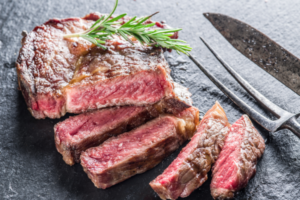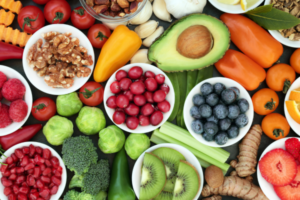I. Introduction
In the realm of culinary delights, few things spark the imagination quite like the fusion of flavours from different cultures. Asian fusion cuisine, in particular, embodies this creative amalgamation, blending the best of various Asian culinary traditions into mouth watering dishes that tantalise the taste buds and ignite the senses.
At the heart of this culinary exploration lies the vibrant tradition of Thai street food. From bustling markets to humble roadside stalls, Thai street food is a cultural phenomenon, a gastronomic adventure waiting to be savoured. Bursting with bold flavours, aromatic herbs, and spices, Thai street food offers a sensory journey like no other.
In this article, we embark on a tantalising exploration of the diverse flavours of Thai street food. From the bustling streets of Bangkok to the tranquil villages of northern Thailand, we delve into the rich tapestry of flavours that define this beloved culinary tradition. Join us as we uncover the secrets of Thai street food, from its humble beginnings to its status as a global culinary sensation. Get ready to tantalise your taste buds and embark on a culinary journey like no other!
II. The Rich Tapestry of Thai Street Food
Thai street food culture is a vibrant tapestry woven from centuries of history, tradition, and innovation. To truly appreciate its richness, we must first delve into its historical roots.
Historical Background of Thai Street Food Culture
Thai street food traces its origins back to ancient times when roadside vendors and bustling markets were the heartbeats of Thai communities. These humble beginnings were fueled by a necessity to provide quick, affordable meals to busy city dwellers and weary travellers. Over time, street food became ingrained in Thai culture, evolving into a cherished culinary tradition that reflects the country’s rich cultural heritage.
Diversity in Ingredients and Cooking Techniques
One of the most captivating aspects of Thai street food is its incredible diversity. Thai cuisine is renowned for its bold flavours, aromatic herbs, and spices, all of which come together harmoniously in street food dishes. From fiery curries to tangy salads and savoury stir-fries, Thai street food offers a tantalising array of flavours and textures to suit every palate. What’s more, the cooking techniques employed by street food vendors are as varied as the dishes themselves. From sizzling woks to smoking grills and steaming pots, the streets of Thailand are alive with the sights, sounds, and smells of culinary creativity.
Influence of Regional Cuisines on Thai Street Food
Another fascinating aspect of Thai street food is its diverse regional influences. Thailand is a melting pot of cultures, with each region boasting its own unique culinary traditions and flavours. From the spicy dishes of the north to the seafood-centric cuisine of the south, Thai street food reflects the country’s geographical and cultural diversity. Whether you’re exploring the bustling streets of Bangkok or the tranquil villages of Chiang Mai, you’re sure to encounter a wide range of regional specialties that showcase the rich tapestry of flavors that define Thai cuisine.
III. Exploring the Flavors: Key Ingredients and Techniques
As we embark on our culinary journey through the vibrant world of Thai street food, it’s essential to understand the key ingredients and cooking techniques that give these dishes their distinct flavours and textures.
Key Ingredients Used in Thai Street Food
- Fresh Herbs and Spices: At the heart of Thai cuisine lies a rich tapestry of fresh herbs and spices that lend depth and complexity to dishes. From fragrant lemongrass and pungent galangal to fiery bird’s eye chilli and aromatic kaffir lime leaves, Thai street food is a symphony of flavours that dance on the palate.
- Aromatic Pastes and Sauces: Central to many Thai street food dishes are aromatic pastes and sauces that serve as the building blocks of flavour. From the iconic red and green curry pastes to tangy tamarind and fish sauce-based sauces, these condiments add depth, richness, and complexity to a wide range of dishes.
- Staple Proteins and Vegetables: Thai street food is also characterised by its use of staple proteins and vegetables. From succulent grilled meats and seafood to crisp vegetables and tofu, Thai street food offers something for every palate. Whether it’s the tender chicken in a fragrant green curry or the plump shrimp in a spicy tom yum soup, the quality and freshness of the ingredients are key to creating the vibrant flavours that define Thai cuisine.
Cooking Techniques Commonly Employed
- Stir-frying: Stir-frying is a staple cooking technique in Thai street food, characterised by high heat and quick cooking times. This method allows ingredients to retain their vibrant colours, crisp textures, and bold flavours, resulting in dishes that are both visually stunning and deliciously flavorful.
- Grilling: Grilling is another popular cooking technique in Thai street food, imparting a smoky flavour and charred exterior to meats, seafood, and vegetables. Whether it’s skewered satay grilled over an open flame or whole fish cooked on a hot grill, grilling adds depth and complexity to Thai dishes.
- Steaming: Steaming is a gentle cooking technique commonly used in Thai street food to cook delicate ingredients such as dumplings, fish, and vegetables. This method preserves the natural flavours and nutrients of the ingredients while imparting a tender texture and subtle aroma.
- Deep-frying: Deep-frying is employed to create crispy and indulgent treats that are beloved by locals and visitors alike. From crispy spring rolls and golden-brown tempura to crunchy chicken wings and fluffy Thai-style donuts, deep-frying adds a satisfying crunch to Thai street food dishes.
IV. The Fusion Factor: Creative Twists and Innovations
In recent years, Thai street food has embraced a wave of creativity and innovation, incorporating influences from global cuisines to create exciting fusion dishes that push the boundaries of tradition.
Influence of Global Cuisines on Thai Street Food
One of the most striking aspects of Thai street food is its ability to absorb and adapt influences from around the world. From Chinese and Indian spices to European cooking techniques and American fast food, Thai street food reflects a melting pot of culinary influences. This cross-cultural exchange has resulted in a diverse array of flavours and ingredients that add depth and complexity to traditional Thai dishes.
Creative Combinations and Reinterpretations
Thai chefs and street food vendors are known for their ingenuity and willingness to experiment with new flavours and ingredients. This creative spirit has led to the emergence of innovative dishes that blend traditional Thai flavours with contemporary twists. Whether it’s a fusion of Thai and Japanese sushi rolls or a Thai-inspired take on classic Italian pasta dishes, these creative combinations and reinterpretations showcase the endless possibilities of Thai street food.
Examples of Popular Fusion Dishes in Thai Street Food Culture
- Thai Basil Chicken Pizza: A delicious fusion of Thai flavours and Italian-American comfort food, Thai basil chicken pizza features a crispy crust topped with spicy basil chicken, fresh vegetables, and gooey melted cheese.
- Pad Thai Tacos: Combining the flavours of Thailand and Mexico, pad Thai tacos feature stir-fried noodles, crispy tofu or shrimp, and tangy tamarind sauce served in soft taco shells and topped with crunchy peanuts and fresh herbs.
- Green Curry Ramen: A creative fusion of Japanese ramen and Thai green curry, green curry ramen features rich and creamy coconut milk-based broth infused with fragrant green curry paste, tender noodles, and a medley of vegetables and proteins.
These examples are just a glimpse of the exciting fusion dishes you can discover on the bustling streets of Thailand. With its boundless creativity and willingness to embrace new flavours and ideas, Thai street food continues to captivate and delight food lovers around the world.
V. Must-Try Thai Street Food Dishes
When it comes to Thai street food, the options are endless, but there are a few standout dishes that are not to be missed. These must-try delights capture the essence of Thai cuisine and are beloved by locals and visitors alike.
Pad Thai: The Iconic Stir-Fried Noodle Dish
Pad Thai is perhaps the most iconic of all Thai street food dishes. This flavorful stir-fried noodle dish features thin rice noodles cooked with eggs, tofu, shrimp or chicken, bean sprouts, and green onions, all tossed in a tangy and slightly sweet tamarind sauce. Garnished with crushed peanuts, fresh cilantro, and a wedge of lime, Pad Thai is a symphony of flavours and textures that perfectly embodies the essence of Thai cuisine.
Som Tum: Spicy Green Papaya Salad
Som Tum is a refreshing and spicy salad made from shredded green papaya, cherry tomatoes, green beans, peanuts, and chilli peppers, all dressed in a tangy and spicy dressing made from lime juice, fish sauce, and palm sugar. This vibrant salad is bursting with bold flavours and is the perfect accompaniment to any Thai meal.
Gai Yang: Grilled Chicken Skewers with Spicy Dipping Sauce
Gai Yang, or Thai grilled chicken skewers, are a popular street food snack loved for their smoky flavour and tender texture. The chicken is marinated in a mixture of garlic, cilantro, lemongrass, and fish sauce before being grilled to perfection. Served with a spicy dipping sauce made from chilli peppers, garlic, and lime juice, Gai Yang is a delicious and satisfying treat that’s sure to please.
Tom Yum: Hot and Sour Soup with Shrimp or Chicken
Tom Yum is a classic Thai soup known for its bold and vibrant flavours. Made from a fragrant broth flavoured with lemongrass, kaffir lime leaves, galangal, and chilli peppers, Tom Yum is bursting with spicy, sour, and savoury notes. Additions of shrimp or chicken, mushrooms, and tomatoes round out this flavorful soup, making it a must-try dish for any Thai food enthusiast.
Mango Sticky Rice: Sweet and Refreshing Dessert Option
No Thai meal is complete without a sweet treat, and Mango Sticky Rice is the perfect way to end your culinary adventure. This simple yet delicious dessert features ripe mango slices served atop sweet sticky rice, drizzled with a rich coconut cream sauce and sprinkled with toasted sesame seeds. The combination of sweet mango, creamy coconut, and chewy rice makes Mango Sticky Rice a heavenly finale to any Thai street food feast.
These must-try Thai street food dishes offer a tantalising glimpse into the rich and diverse flavours of Thai cuisine. Whether you’re exploring the bustling streets of Bangkok or the quaint markets of Chiang Mai, be sure to seek out these culinary delights for an unforgettable dining experience.
VI. Where to Experience Thai Street Food
To truly experience the vibrant flavours and bustling atmosphere of Thai street food, there are several places you can visit throughout Thailand and beyond.
Street Food Markets in Thailand
Thailand’s street food markets are the beating heart of the country’s culinary scene, offering a dizzying array of flavours and aromas that tantalise the senses. From the famous night markets of Bangkok, such as Chinatown’s Yaowarat and the vibrant stalls of Asiatique, to the bustling markets of Chiang Mai and the seaside delights of Phuket’s Patong Beach, street food markets are where you’ll find some of the most authentic and delicious Thai dishes. Whether you’re craving spicy curries, fragrant soups, or sweet treats, the street food markets of Thailand have something to satisfy every palate.
Thai Restaurants Specialising in Street Food Cuisine
For those who prefer a more comfortable dining experience without sacrificing authenticity, Thai restaurants specialising in street food cuisine offer a fantastic alternative. These restaurants often recreate the bustling atmosphere of Thailand’s street food markets, with colourful decor, lively music, and a wide range of dishes to choose from. From hole-in-the-wall eateries to upscale dining establishments, Thai street food restaurants serve up a mouthwatering selection of classics like Pad Thai, Som Tum, and Gai Yang, as well as lesser-known regional specialties that are sure to impress even the most discerning foodies.
Fusion Restaurants Offering Innovative Twists on Traditional Thai Dishes
For a truly unique dining experience that combines the best of Thai cuisine with innovative twists and global influences, fusion restaurants are the way to go. These creative eateries take traditional Thai dishes and reimagine them in exciting and unexpected ways, incorporating elements from other cuisines to create dishes that are both familiar and innovative. Whether it’s a Thai-inspired pizza topped with spicy basil chicken and crispy basil leaves, or a green curry ramen infused with Japanese flavours, fusion restaurants offer a culinary adventure that is sure to delight the taste buds.
Whether you choose to explore the lively street food markets of Thailand, dine at a traditional Thai restaurant, or indulge in the creative offerings of a fusion eatery, one thing is for certain: experiencing Thai street food is an unforgettable journey that will leave you craving more. So grab your chopsticks and get ready to embark on a culinary adventure like no other!
VII. Tips for Enjoying Thai Street Food
While exploring the vibrant world of Thai street food can be an exciting culinary adventure, it’s essential to keep a few tips in mind to ensure a safe and enjoyable dining experience.
Etiquette and Customs When Dining at Street Food Stalls
- Respect the Vendor: Thai street food vendors take great pride in their craft, so be sure to greet them with a friendly smile and a respectful “sawasdee kha” (if you’re female) or “sawasdee krub” (if you’re male).
- Point and Smile: If you’re not fluent in Thai, don’t worry! Most vendors are accustomed to serving tourists and will appreciate simple gestures like pointing to what you want and smiling.
- Be Patient: Thai street food stalls can get busy, especially during peak hours, so be prepared to wait a bit for your food. Use this time to soak in the sights, sounds, and smells of the bustling market around you.
Hygiene Considerations and Food Safety Tips
- Look for Cleanliness: While Thai street food is generally safe to eat, it’s essential to choose vendors that maintain a clean and hygienic environment. Look for stalls with clean cooking surfaces, fresh ingredients, and proper food handling practices.
- Watch for Freshness: Freshness is key when it comes to street food, so opt for stalls that have a high turnover of customers and use fresh ingredients.
- Stay Hydrated: Thailand’s tropical climate can be hot and humid, so be sure to stay hydrated while exploring the street food markets. Carry a bottle of water with you and take frequent breaks to cool off in the shade.
Recommendations for Adventurous Eaters Looking to Try New Flavors
- Start Slow: If you’re new to Thai cuisine or have a sensitive palate, start with milder dishes like Pad Thai or Mango Sticky Rice before moving on to spicier options.
- Embrace the Heat: Thai cuisine is known for its bold flavours and spicy dishes, so don’t be afraid to embrace the heat! Just be sure to have a refreshing drink on hand to cool off if things get too spicy.
- Try Something New: Thai street food offers a wide range of unique and exotic dishes, so don’t be afraid to step out of your comfort zone and try something new. From crispy insect snacks to tangy fermented foods, you never know what delicious surprises you might discover!
By following these tips, you’ll be well-equipped to navigate the vibrant world of Thai street food and enjoy a safe and memorable culinary adventure. So go ahead, explore the bustling markets, sample the mouthwatering dishes, and immerse yourself in the rich tapestry of flavours that define Thai cuisine!
VIII. Conclusion
As we come to the end of our culinary journey through the vibrant world of Thai street food, let’s take a moment to reflect on the incredible flavours and diverse offerings that we’ve encountered along the way.
Recap of the Vibrant Flavors and Diverse Offerings of Thai Street Food
From the fiery spices of Tom Yum soup to the refreshing sweetness of Mango Sticky Rice, Thai street food has tantalized our taste buds with its bold flavours and diverse array of dishes. Whether it’s the iconic Pad Thai or the spicy Som Tum salad, each bite has been a journey of discovery, a symphony of flavours that reflects the rich culinary heritage of Thailand.
Encouragement for Readers to Explore and Experience the Rich Culinary Heritage of Thailand
As we bid farewell to the bustling markets and lively street food stalls of Thailand, I encourage you, dear readers, to continue exploring and experiencing the rich culinary heritage of this fascinating country. Whether you’re a seasoned foodie or a curious traveller, there’s always something new to discover and savour in the vibrant world of Thai cuisine.
Closing Thoughts on the Fusion of Flavors and Cultures in Asian Cuisine
Finally, let’s reflect on the fusion of flavours and cultures that define Asian cuisine as a whole. From the delicate balance of spices in Indian curry to the umami-rich broths of Japanese ramen, Asian cuisine is a melting pot of flavours and influences that reflects the diversity and interconnectedness of our world. As we continue to explore and celebrate the rich tapestry of Asian cuisine, let’s embrace the fusion of flavours and cultures that make it so unique and delicious.
In conclusion, I hope this culinary journey has inspired you to embark on your own adventures in Thai street food and beyond. So go ahead, explore the bustling markets, sample the mouthwatering dishes, and immerse yourself in the vibrant world of Asian cuisine.



